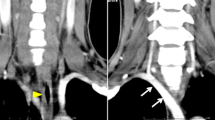Abstract
A non-recurrent inferior laryngeal nerve (NRILN) is a rare anomaly that may increase the risk of injury during thyroid surgery. A NRILN results from an embryologic developmental abnormality of the aortic arches, demonstrated by the absence of the brachiocephalic artery and the presence of an aberrant subclavian artery (arteria lusoria). In our experience 100% of 104 patients with a NRILN were shown to have these abnormalities. We postulated that duplex scanning of the brachiocephalic artery could identify patients at risk of a NRILN. Twelve patients with an operative diagnosis of a right NRILN and associated vascular abnormalities underwent postoperative duplex scanning of the brachiocephalic artery. The examination was performed using a 7.5 or 3.5 MHz transducer. The average duration of assessment was 5 min. The absence of the brachiocephalic artery and the direct origin of the right common carotid artery from the arch of the aorta were demonstrated in each patient. Duplex scanning is a simple noninvasive method of identifying patients with the arterial abnormalities responsible for a NRILN. This may be used in the preoperative assessment of selected patients.
Résumé
Le nerf laryngé inférieur non-récurrent (NRILN) est une anomalie rare qui expose à un risque accru de paralysie récurrentielle lors de la chirurgie thyroïdienne et parathyroïdienne. Cette anomalie du côté droit est la conséquence d'une anomalie embryologique du développement des arcs branchiaux, comme l'atteste l'absence d'artère brachiocéphalique (ABC) et la présence d'une artère subclavière aberrante (arteria lusoria). Dans notre expérience, la totalité des 104 patients porteurs d'un NRILN présentaient ces anomalies vasculaires. A l'inverse de certaines méthodes invasives ou coûteuses (artériographie, IRM), l'échographie Doppler de l'ABC nous est apparue comme un moyen simple et fiable de diagnostiquer indirectement la présence d'un NRILN. Douze patients présentant un NRILN droit et une absence d'ABC diagnostiqués en cours d'intervention ont bénéficié d'une échographie Doppler de l'ABC. Les sondes utilisées étaient de deux types, une sonde 7,5 Hz ou une sonde 3,5 Hz. La durée moyenne d'examen a été de 5 minutes. L'absence d'ABC ainsi que l'origine de l'artère carotide commune droite directement depuis l'arc de l'aorte ont été retrouvées dans tous les cas. L'échographie Doppler apparaît comme être une méthode simple et non invasive pour identifier les patients présentant les anomalies vasculaires associées à un NRILN. Nous pensons que cet examen devrait être proposé dans le bilan pré-opératoire de certains patients à risque.









Similar content being viewed by others
References
Arkin A (1936) Double aortic arch with total persistence of the right and isthmus stenosis of the left arch. A new clinical and x-ray picture. Report of 6 cases in adults. Am Heart J 11:444–474
Avisse C, Marcus C, Delattre JF, Marcus C, Cailliez-Tomasi JP, Palot JP, Ladam-Marcus V, Menanteau B, Flament JB (1998) Right non-recurrent inferior laryngeal nerve and arteria lusoria: the diagnostic and therapeutic implications of an anatomic anomaly. Review of 17 cases. Surg Radiol Anat 20: 227–232
Bayford D (1789) An account of a singular case of obstructed deglutition. Mem Med Soc London 2: 271–272
Defechereux T, Albert V, Alexandre J, Bonnet P, Hamoir E, Meurisse M (2000) The inferior non-recurrent laryngeal nerve: a major surgical risk during thyroidectomy. Acta Chir Belg 100: 62–67
Henry JF, Audiffret J, Denizot A, Plan M (1988) The non-recurrent inferior laryngeal nerve: review of 33 cases, including two on the left side. Surgery 104: 977–984
Katz AD (1986) Extralaryngeal division of the recurrent laryngeal nerve: report on 400 patients and the 721 nerves measured. Am J Surg 152: 407–410
Katz AD, Nemiroff P (1993) Anastomoses and bifurcation's of the recurrent laryngeal nerve: report of 1,177 nerves visualized. Am Surg 59: 188–191
Kern KA (1993) Medicolegal analysis in the diagnosis and treatment of surgical endocrine disease. Surgery 114: 1167–1174
Kern K (1995) The anatomy of surgical malpractice claims. Bull Am Coll Surg 80: 35–49
Lescalie F, Peret M, Reigner B, Cronier P, Pillet J (1992) Reconstruction of an abnormal artery observed in an 11 mm embryo: considerations on the embryologic origin of the subclavian artery. Surg Radiol Anat 14: 71–79
Materazzi G, Berti P, Iacconi P, Miccoli P (2000) Non-recurrent laryngeal nerve predicted before thyroidectomy by preoperative imaging. J Am Coll Surg 191: 580
Netterville J, Stone R, Luken E, Civantos F, Ossoff R (1993) Silastic medialization and arytenoids adduction: a review of 116 procedures: the Vanderbilt experience. Ann Otol Rhinol Laryngol 102: 413–424
Proye CAG, Carnaille BM, Goropoulos A (1991) Non-recurrent and recurrent inferior laryngeal nerve: a surgical pitfall in cervical exploration. Am J Surg 162: 495–496
Raffaelli M, Iacobone M, Henry JF (2000) The "false" non-recurrent inferior laryngeal nerve. Surgery 128: 1082–1087
Sato I, Sato T, Shimada K (1997) Communication between the superior cervical sympathetic ganglion and the inferior laryngeal nerve. J Anat 190: 147–148
Saunders G, Uyeda RY, Karlan MS (1983) Non-recurrent inferior laryngeal nerves and their association with a recurrent branch. Am J Surg 146: 501–503
Srinivasan V, Premachandra DJ (1997) Non-recurrent laryngeal nerve: identification during thyroid surgery. ORL J Otorhinolaryngol Relat Spec 59: 57–59
Stedman GW (1823) A singular distribution of the nerves and arteries of the neck and the top of the thorax. Edinb Med Surg J 19: 564–565
Watanabe A, Kawabori S, Osanai H, Taniguchi M, Hosokawa (2001) Preoperative computed tomography diagnosis of a non-recurrent recurrent inferior laryngeal nerve. Laryngoscope 111: 1756–1759
Author information
Authors and Affiliations
Corresponding author
Rights and permissions
About this article
Cite this article
Devèze, A., Sebag, F., Hubbard, J. et al. Identification of patients with a non-recurrent inferior laryngeal nerve by duplex ultrasound of the brachiocephalic artery. Surg Radiol Anat 25, 263–269 (2003). https://doi.org/10.1007/s00276-003-0135-9
Received:
Accepted:
Published:
Issue Date:
DOI: https://doi.org/10.1007/s00276-003-0135-9




